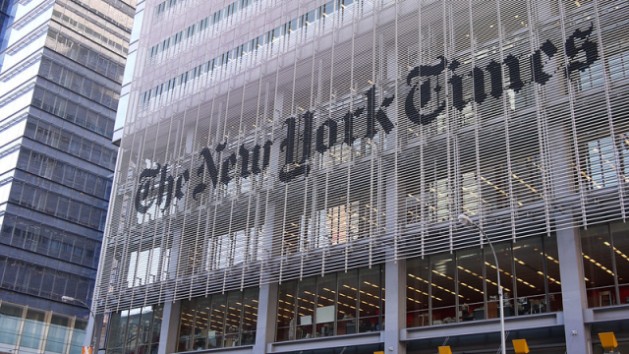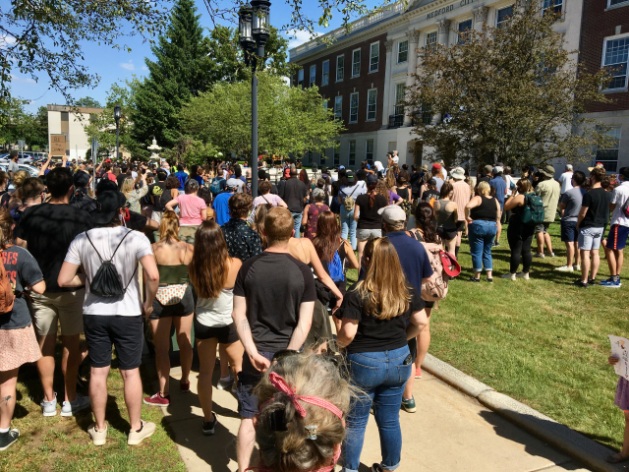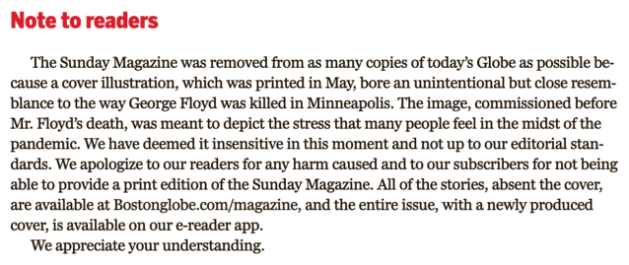We just got back from a huge Black Lives Matter protest and march organized by Mobilize Medford. A crowd that I’d estimate at well over 1,000 people gathered in front of City Hall to protest against racism and police brutality. Afterwards, the protesters marched and chanted along High Street — Paul Revere’s route — to West Medford. We left the march at Grace Episcopal Church, where we’d parked our car. It was an impressive turnout for an important cause.
Tag: Black Lives Matter

Photo (cc) 2010 by samchills.
At least at the moment, I have little to add to the story of James Bennet’s departure as editorial-page editor of The New York Times beyond what Ben Smith of the Times, Tom Jones of the Poynter Institute and Jon Allsop of the Columbia Journalism Review have written, and what I wrote last week.
As Smith, Jones and Allsop point out, Bennet’s misguided decision to run Sen. Tom Cotton’s ugly commentary advocating violence against protesters should be seen as part of a larger story that encompasses Wesley Lowery’s unfortunate experience at The Washington Post, the resignation of Philadelphia Inquirer executive editor Stan Wischnowski over his paper’s horrendous “Buildings Matter, Too” headline, and the right-wing Pittsburgh Post-Gazette’s meltdown over Alexis Johnson, a Black reporter whom they claimed couldn’t be trusted to cover Black Lives Matter protests because of an innocuous tweet she had posted.
Because of the Times’ central place in our media culture, Bennet’s departure is the big story. As the coverage makes clear, Bennet lurched from one misstep to another during his time as editorial-page editor, so it would be a mistake to attribute his departure solely to the Cotton op-ed. I don’t think he ever fully recovered from his mishandling of a Bret Stephens column in which Stephens came very close to endorsing a genetic basis for intelligence.
Bennet will be replaced through the election on an interim basis by deputy editorial-page editor Katie Kingsbury, who won a Pulitzer when she was at The Boston Globe. Kingsbury is terrific, and I hope she’s given a chance to earn the job.
Finally, a semi-related incident involving the Globe. You may have seen this on the front of Sunday’s print edition:
There’s no question that the cover, which you can see here, would have been considered entirely inoffensive before a police officer killed George Floyd. Even now I’m not sure how many readers would have been outraged. Still, I think the Globe made the right call. An abundance of caution and sensitivity is what’s needed at the moment.

DeRay Mckesson earlier this year. Public domain photo by the LBJ Library.
Previously published at WGBHNews.org.
In September 2018, President Donald Trump won an important First Amendment victory. By a 3-0 vote, the U.S. Court of Appeals for the 6th Circuit ruled that neither Trump nor his campaign could be held liable for injuries suffered by protesters at the hands of Trump supporters during a March 2016 rally even though the then-candidate had yelled to “get ’em out of here.”
The court’s reasoning was based on the straightforward application of free-speech principles: Trump had not advocated violence at the Kentucky rally (in fact, he had also said “don’t hurt ’em”), and therefore he couldn’t be successfully sued even though some people were roughed up.
The decision may have been a disappointment for those who thought Trump should be held accountable for his careless words. But under the First Amendment, political speech receives the highest level of protection except in the most extreme circumstances.
Now, though, those principles are in danger. Based on a similar set of facts, the 5th Circuit ruled recently that a police officer in Baton Rouge, Louisiana, can sue Black Lives Matter activist DeRay Mckesson for injuries he received at the hands of a rock-throwing protester — even though, as The Washington Post reported, “Mckesson did not throw the rock or tell anyone else to throw it.”
Mckesson had organized the 2016 demonstration following the police killing of a black man named Alton Sterling. The police officer, whose identity has not been revealed, claims that Mckesson acted negligently by not foreseeing that the demonstration could become violent.
“The goal of lawsuits like these is to prevent people from showing up at a protest out of the fear that they might be held responsible if anything happens,” Mckesson said in a statement released by the ACLU, which earlier this month asked the Supreme Court to take up the case. “If this precedent lasts, it could make organizers all across the country responsible for all types of things they have no control over, such as random people coming into a protest and causing problems. We can’t let that happen.”
The Supreme Court precedent that protected Trump and that, by all rights, should protect Mckesson is NAACP v. Claiborne Hardware Co., a case decided in 1982. The NAACP in 1966 called for a boycott of white-owned businesses in Claiborne County, Mississippi — a nonviolent form of protest that nevertheless led to some acts of violence. In 1969, several of the business owners sued the NAACP and were successful in the state courts. But the Supreme Court ruled unanimously that the NAACP could not be held liable for engaging in nonviolent free-speech activities regardless of actions taken by people not under the organization’s control.
Although the cases against Trump and Mckesson, like the case against NAACP, were for alleged civil offenses, it’s also worth noting the high bar the Supreme Court has set for incitement to violence in criminal cases. In the landmark 1969 case of Brandenburg v. Ohio, the court threw out the conviction of Ku Klux Klan leader Clarence Brandenburg because the threats he made at a rally against African Americans and Jews were non-specific and would not result in imminent violence.
In their petition to the Supreme Court, the ACLU’s lawyers argue that allowing the lawsuit against Mckesson to proceed would have a chilling effect on anyone who might wish to organize a nonviolent protest.
“Given the regularity with which violence and First Amendment activity co-occur and the vagaries of state law liability rules,” the lawyers wrote, “only the most intrepid citizens would exercise their rights and risk ruinous liability if they could be held liable for the wrongful acts of others.”
Ben Wizner, director of the ACLU’s Speech, Privacy and Technology Project, put it this way in the Washington Post story: “If this is allowed to stand, anybody can show up and throw a rock at a protest to bankrupt a movement they disagree with. People know when they step into the street that they might have to spend some hours in jail or pay a fine. But if they might have to pay a multi-million dollar civil judgment — that’s something they’re not prepared for, and can’t possibly be expected to prepare for.”
The case should prove to be a telling indicator of where the Supreme Court stands on free speech now that it has swung sharply to the right. Only four of the nine justices are needed take up the case.
Traditionally, even the court’s more conservative members have proved to be staunch advocates of the First Amendment. But if Trump’s justices, Neil Gorsuch and Brett Kavanaugh, were to break with that tradition, the case of DeRay Mckesson v. John Doe could prove to be a signal moment in our march to a less open, less free society.

Diamond Reynolds, who live-streamed the last moments of her boyfriend, Philando Castile, on Facebook Live. Photo (cc) by Lorie Schaull.
In April Facebook Live was launched, allowing users to broadcast live and tap the social media giant’s colossal audience. But it was last week, as the world now knows, that Facebook Live had its watershed, technology-transforming-history moment in the broadcast of Philando Castile’s final moments as filmed and narrated by his girlfriend after he was shot by a police officer.
To understand what Facebook Live might mean for newsrooms, Storybench sat down with Northeastern University journalism professors Dan Kennedy and John Wihbey.
A powerful conclusion to this New York Times editorial:
The “Black Lives Matter” movement focuses on the fact that black citizens have long been far more likely than whites to die at the hands of the police, and is of a piece with this history. Demonstrators who chant the phrase are making the same declaration that voting rights and civil rights activists made a half-century ago. They are not asserting that black lives are more precious than white lives. They are underlining an indisputable fact — that the lives of black citizens in this country historically have not mattered, and have been discounted and devalued. People who are unacquainted with this history are understandably uncomfortable with the language of the movement. But politicians who know better and seek to strip this issue of its racial content and context are acting in bad faith. They are trying to cover up an unpleasant truth and asking the country to collude with them.








